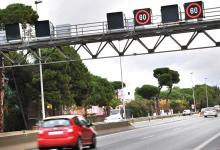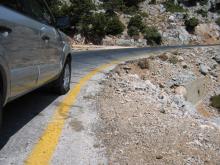The US is losing its advantage in the ITS sector because of a lack of strategic leadership, according to a new report from the Information Technology and Innovation Foundation. Here, Stephen Ezell, one of the report's authors, talks to ITS International about what can be done to remedy the situation. A new report from the Information Technology and Innovation Foundation (ITIF), Explaining International IT Leadership: Intelligent Transportation Systems, makes for sobering reading within the US ITS community.

Once deployed, ITS system can achieve significant, positive benefit: cost rations, and yet all too often politicians would prefer the photo opportunity afforded by the groundbreaking ceremony for a new road
The US is losing its advantage in the ITS sector because of a lack of strategic leadership, according to a new report from the Information Technology and Innovation Foundation. Here, Stephen Ezell, one of the report's authors, talks to ITS International about what can be done to remedy the situation
A new report from the"Integrated, wide-scale deployments of ITS in the domestic market are important in three ways," says Stephen Ezell, Senior Analyst with ITIF. "First is the ability to mitigate congestion. The figures are well-known: traffic congestion costs the US economy an estimated $200 billion annually, and each year the traveller spends a week on average in his or her car. Traffic accidents and fatalities cost the US economy $230 billion annually as well. There is also an impact on the ability to get goods delivered on time, and on the ability of supply chain organisations such as
"With no world-leading ecosystem in which to innovate, domestic ITS manufacturers are left with a very much reduced ability to develop world-leading products."
A frustration, according to Ezell, is that many ITS technologies were in fact innovated in the States but it is other countries which have raced ahead with deployment. Japan, South Korea, Singapore and Taiwan are in the vanguard, although some countries in Europe, notably Sweden, Holland, and the United Kingdom, are also favourably positioned, he says.
"North American companies aren't prohibited from competing internationally but they are disadvantaged. There are some ready examples from South America where Asian manufacturers have been able to reference installations at home when competing for major contracts. It is hitting US ITS companies and you don't have to look too far to see that.
"There are many good-quality ITS deployments in the US. Among them are adaptive signalling, ramp metering and HOT lanes. But these are sporadic, anecdotal and isolated."
"Policy is the problem"
Ezell dismisses non-policy factors such as geographical differences as a main cause."Certainly, Japan, South Korea and Singapore have very constrained geographies which led them to recognise very early that they need to optimise operational effectiveness. Higher population densities mean that deployed ITS systems tend to serve larger populations. But despite the fact that the US has many dense population centres with constrained geographies it has not implemented ITS to the extent leading Asian countries have.
"In fact, the US has some comparative advantages: a larger population means that the costs of deployment can be amortised across a greater number of drivers. Moreover, ITS relies on IT, where costs decrease with scale; 10 or 15 years ago, there was a reliance on roadside infrastructure and inductive loops. Now we have 3G communications and cell phone proliferation. The costs of deployment and access to information have shifted.
"Policy rather than population density plays a greater role in explaining country leadership in ITS. Countries such as Japan regard traffic data as a key informational resource. That is recognised at the ministerial level. European countries also recognise the importance of ITS systems. In the US, the high-level ownership just hasn't yet been there."
Nor, Ezell continues, are consumer attitudes an obstacle.
"While compiling the report we looked, for instance, at contactless payments using smart phones. There are very high rates of consumer electronics adoption in the Far East which allow this to be relatively common. If you look at mobile phone features like text messaging, 3G networks, or even location-based GPS applications, it's not that US consumers don't want these. Indeed, despite the naysayers, they have been readily adopted in Western mobile telecom markets, it's just that the technology typically has taken three to four years longer to reach the US market. When it does, it's enthusiastically taken up - just look at the phone applications of traveller information provided by such companies as
Federal Government's role
The very nature of ITS means that the US's Federal Government has to take on a leadership role, according to Ezell."The Federal Government might only directly control a small proportion of the country's roadways, but fully integrated systems such as IntelliDrive, have to work nationally. I want to know that if I'm relying on the CICAS system for intersection management that it's going to work the same from state to state; if we're using DSRC to have vehicles talk to traffic signals, they need to be able to do so all the way from Florida to California.
"Think of ITS as the Interstate Highway System of the 21st century: the Interstate system would never have existed without the federal government taking a fundamental leadership role, providing funding, laying out the routes, and even specifying the width of the highway lanes. Likewise with ITS: the Federal Government need to take a lead role once again, providing funding, developing technology standards and spearheading deployment and implementation of large-scale systems.
"The statutory mission of the USDOT's RITA ITS Joint Program Office [JPO] is research and development, not deployment. We need a deployment mission, to move towards the Federal Government funding of large-scale research, demonstrations, testing and evaluation projects."
By way of example, Ezell says that the ITS JPO could, or should, be tasked with developing and implementing real-time travel information services at the national level.
"The JPO has embarked on a five-year research programme into IntelliDrive, a multimodal initiative that aims to enable safe, interoperable networked wireless communications to achieve cooperative vehicle-to-vehicle and vehicle-to-highway integration. While certainly important, USDOT needs to make a fundamental shift from a focus solely on ITS research to include a much greater focus on ITS deployment, perhaps by beginning with model implementations of IntelliDrive in several large US cities. The United States also needs more federal leadership in moving toward a vehicle miles travelled (VMT) pricing system and supporting deployment of computerised adaptive traffic signal lights."
From here to there
The question - or the challenge - is how the US gets from where it is at the moment to where it needs to be. The discussion centres on some very large and sophisticated systems, the complexity of which cannot rely on 50 separate states to take forward.That makes no sense, says Ezell: "There's a lot of specialisation involved in numerous areas. We need centralised expertise.
"Historically, ITS deployments haven't appeared especially compelling. Elected officials want the photo opportunity that comes with the groundbreaking ceremony for a new road, not a behind-the-scenes ITS solution which makes existing roads work better.
"And yet the benefit-to-cost ratio of an ITS deployment can be as high, on average, as 9:1. For specific ITS deployments, such as signal optimisation, it can be as high as 38:1. ITS offers tremendous bang for the buck, but since US states haven't been held accountable for system performance, they haven't been incentivised to preference solutions that deliver superior benefit-cost returns. There's currently no drive to invest in cost-effectiveness; we're still mired in a situation where funding is based on lane mileages and the numbers of miles driven.
"ITS both enables collection of real-time performance data and provides the ability to maximise operational performance of transportation systems. Congress should require state DOTs and metropolitan planning organisations to develop performance management processes which monitor progress towards national goals, set by Congress, relating to transportation-related fatalities and injuries, congestion, travel times and the environment. Japan and South Korea already do this, and, as in those countries, that data should be published at least annually."
Financing the dream
There remains the reality of actually paying for what Ezell and ITIF are proposing. In reality, although much is being asked here, especially in terms of a shift in mindset, Ezell says that in governmental terms the levels of necessary funding are achievable."At some point we will have a reauthorisation of the transportation bill and that will be to the tune of $65-70 billion. Within that, it shouldn't be hard to find $1 billion for ITS systems deployment, and another $1 to 1.5 billion for research into large-scale ITS systems with the largest potential impact on network performance. Keep in mind that ITS investments are not consumption spending - they provide lasting future benefits. For example, the US Government Accountability Office has said that a $1.2 billion investment nationally in a real-time travel information system would provide benefits over a decade of $30.2 billion, a 25:1 benefits-costs ratio.
"These systems cost up-front, but as investments they deliver substantial long-term returns; which benefit everyone."
Persuading the masses
"The fundamental challenge is to get the public to perceive of the transportation system as an asset. When gas prices rose back in 2008, we saw 6 billion fewer miles driven. The point is that transportation networks aren't free. They're paid for by taxpayers. So how can we exert pressure on politicians? The starting point has to be by educating the public.I don't think that the US is generating anywhere near enough real-time traffic information yet. The American people need to realise that citizens in other countries are already benefitting from deployed ITS technologies that are having a substantial impact in mitigating traffic congestion, accidents and fatalities. Moreover, as budgets grow ever tighter in this country, the public must demand that limited budgets are allocated in the most cost-effective manner. Investments in ITS have clearly shown an outsize ability to positively improve traffic system performance.
"We should also set goals. Japan in its Innovation 2025 initiative is looking to eliminate traffic fatalities entirely by 2025. In the US, traffic casualty figures are the equivalent of a fully loaded Boeing 737 falling out of the sky each day. We may not reach the goals set but they at least give us an aspiration.
Many goals are shared. Urban and rural communities' needs may be different but they can often be addressed by the same systems. Congestion exists even in some of our smallest towns. We can build performance figures around that realisation.
"We'll be going on to Capitol Hill with this report, and speaking and working with those who will influence and be responsible for the formulation of the next reauthorsation bill. "It gets us off to a start. From here, we need to show the major influencers and decision-makers that the US's citizens aren't currently getting the same benefits as those in other countries."








